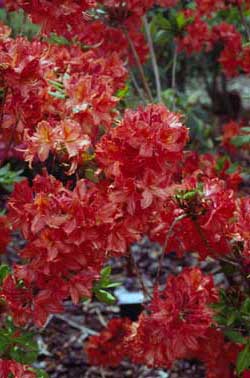Rhododendron
 Rhododendron
Rhododendron
Family Ericaceae
There are up to 800 species; though most of the cultivated plants are hybrids or cultivars developed from wild species.
There are many thousands of such cultivars being grown; most commonly in garden beds; but sometimes as tub plants or as a screen.
Some smaller varieties have also developed specifically as rockery plants.
Some rhododendrons are simply too large for a small garden; but there are hundreds of others that are ideal for any type of smaller garden.
Rhododendrons are mainly evergreen, some are deciduous; and there are both tropical and temperate climate varieties.
Leaves are usually green, though there are a small number with variegated foliage. Young growth is usually lush, and a different colour to the older leaves (eg. bronze green, or a lighter green). Flower heads occur as terminal spikes, and are usually colourful, often very spectacular.
They prefer an acid soils (avoid alkaline/lime soils); with plenty of organic matter, constant moisture, but reasonable drainage. Some will grow in full sun but filtered sunlight is generally preferable or at least light shade during the hottest part of the day. In hotter climates, greater shade is required.
Avoid exposure to severe weather (eg. strong winds, bad frosts, etc).
Most respond to watering during dry periods, fertilising during periods of growth (particularly in the first few years), and maintenance of a thick organic mulch (eg. compost or lucerne hay).
Rhododendrons are normally propagated by cuttings. Cuttings are normally taken in mid summer, after the current season’s growth has become somewhat hardened, but before the wood has turned red or brown (not woody). The cuttings must be kept turgid, this is one important rule. Cuttings respond well to rooting hormones, bottom heat and mist. Cuttings should be about 10 cm long, with the bottom 70% of the leaves removed. Rhododendrons can also be grown from seed and layering. They are not normally grown from seed as the plants hybridize readily and seedlings are usually different to their parents. Layering is a slow, though easy method of propagation (plants can take up to two years to root by layering).
A wide range of pests and diseases can affect Rhododendrons. Red Spider mite is common at some times of the year. Leaf spots and root rots can also become serious at times, particularly in excessively wet conditions. Susceptibility to problems can vary according to the variety being grown, and the locality.
Cultivars
Over 800 species of Rhododendron exist; and many tens of thousands of named cultivars. Many are large plants, even trees. Most however are smaller, fibrous rooted plants, and can be used to great advantage in small gardens.
Azaleas are dealt with earlier in this book…see under Azalea.
Major groups of rhododendrons (other than azaleas) which are useful in small gardens include:
*Rock Rhododendrons -smaller plants with large numbers of smaller but very colourful flowers, and smaller leaves
*Vireyas –tropical species, generally small plants between 60cm and 1.5m tall, with glossy green leaves, and showy flowers that are sometimes fragrant.
*Hybrids – plants suited to temperate climates, named cultivars that have been selected and bred to produce large and colourful flowers, generally leaves are larger than rock rhododendrons and not glossy like the vireyas.
ROCK RHODODENDRONS
R. ‘Blue Diamond’ -upright plant to 1m tall, small leaves, takes full sun in temperate climates, lavender blue flowers.
R. ‘Purple Gem’ -dwarf plant violet to purple flowers, small leaves.
Learn More about Plants through an ACS Plant Variety course.
You may also be interested in....